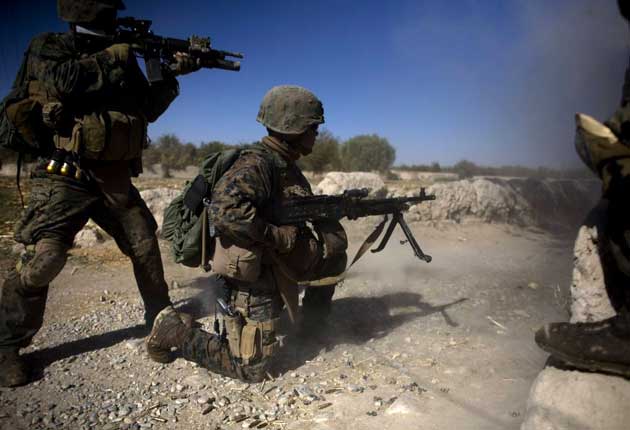US troops take hard line to tame rebels of Sangin

There was so much high explosive raining down it was hard to believe anyone could have survived beneath the two-hour salvo of guided artillery rounds, Hellfire missiles and strafing runs by F/A-18 warplanes and helicopter gunships.
But somehow they did. After every strike Taliban insurgents would fire back defiantly, telling the US Marines they were still there; still alive. "Time for the tactical nuke," Captain Alexander Vanston, a Marine civil affairs officer, said dryly as another 500lb bomb tore through a Taliban position, sending earth and debris billowing hundreds of feet into the cloudless sky.
Bombardment of this intensity in Afghanistan would have been unthinkable just a few months ago, when harsh directives were in place governing Nato's use of air power and British troops practised a kind of counter-insurgency that traced its roots to neighbourhood policing in Northern Ireland. Troops were spread out at patrol bases and checkpoints, a move designed to embed them among the people they were supposed to protect.
But diplomatic cables published by WikiLeaks reveal that US diplomats and commanders, Afghan President Hamid Karzai and local officials in Helmand all privately derided British military operations in the province, especially in Sangin, where the British lost more than 100 troops. One Nato officer described the situation in Sangin as a "Mexican stand-off" between the British and the Taliban. Even some Brits privately questioned what they were doing.
The US Marines who have taken over in Sangin, Afghanistan's deadliest district for foreign troops, are waging a decidedly more aggressive campaign than their predecessors. They have abandoned many of the 22 patrol bases maintained by the British, and, with fewer troops pulling sentry duty, have been mounting hundreds of patrols a month.
"When you fight the COIN [counter-insurgency] fight there has to be a balance," said Major General Richard Mills, the top US Marine commander in Afghanistan. "You focus on the population" – as the British did – "but you can't lose sight of the enemy either. He has to be dealt with."
Gen Mills described Sangin as "key terrain... the anchor for the whole centre" of Helmand, the most violent province in Afghanistan. "It is a battle up there," he said. "No question about it... [The Marines] are out every day, there's contact [fighting] every day... They pulled a very difficult mission."
The increased tempo is designed to draw rebels into a fight in swathes of countryside where they had previously gone unchallenged. Lieutenant Brad Fromm, 24, a platoon leader from New Jersey, explained it as "going out to try to be nice to people but if someone shoots at us we highly intend to kill them".
There's little question which eventuality the Marines expect. Three hours later, Lt Fromm was directing mortars and a Hellfire anti-tank missile on to Taliban marksmen sniping at his men from a tree-line.
Sitting on a strategic crossroads in Helmand province, yet so remote that no government official has ever set foot in parts of the district, Sangin has in some ways become the insurgency's perfect storm. For the past three decades it has been the setting for a brutal tribal war, which the Taliban, in more recent years, have exploited mercilessly to strengthen their grip.
The ferocity of the fighting has taken some Marines aback. Third Battalion 5th Marines (3/5), the unit currently deployed in Sangin, ran into more than 100 firefights in their first month here, taking unprecedented casualties, with 15 killed and about 50 wounded. On one day alone the battalion surgeon treated 17 patients – triple amputees, gunshot or shrapnel wounds, civilians caught in the crossfire.
The toll for those first 30 days is roughly equivalent to that exacted on 40 Commando (the British unit that preceded the Marines) over an entire six-month tour. Yet Gen Mills and others claim that despite the bloody toll the aggression is beginning to pay dividends. "We are taking out a heck of a lot [more] of him than he is of us," Gen Mills claimed. "That's not to say the casualties we're taking up there are acceptable. They aren't. But he's paying a price for what he's trying to do."
Critics of the US approach include civilians trapped in the middle. Haji Gul Mohammad, an elder from northern Sangin, demanded at a recent meeting of elders: "Why are they making mistakes and killing civilians by dropping bombs on their compounds?"
Lieutenant Colonel Jason Morris, commander of 3/5, said almost every allegation of civilian casualties against his Marines was dreamed up by Taliban provocateurs. But if bazaar gossip is any metric, then the propagandists are successfully cultivating an image of the Marines as begetters of violence. "They will send people down to the bazaar to say, 'Have you heard what's going on in X,Y,Z places? It's terrible'," said Phil Weatherill, a British government adviser in Sangin. "It just needs one flicker and it will spread like wildfire."
Subscribe to Independent Premium to bookmark this article
Want to bookmark your favourite articles and stories to read or reference later? Start your Independent Premium subscription today.

Join our commenting forum
Join thought-provoking conversations, follow other Independent readers and see their replies